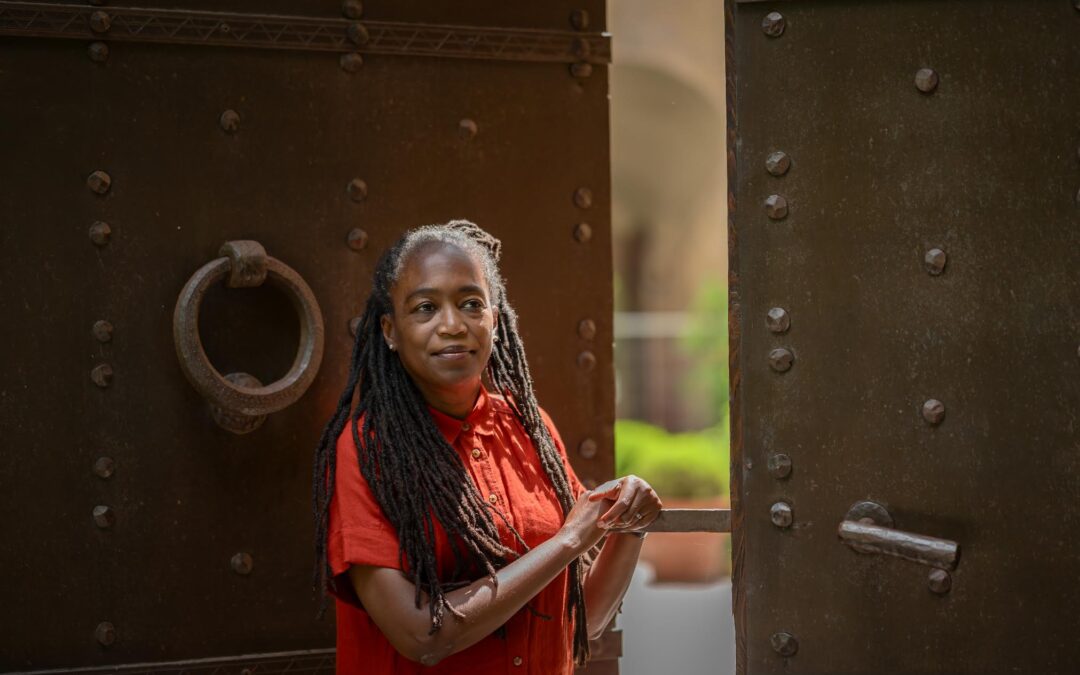Felecia Davis (CRF 2023) is an architect and artist from the United States. Her work connects art, science, engineering and design. She is also a founding member of the Black Reconstruction Collective, a not-for-profit group of Black architects, scholars, and artists supporting design work about the Black diaspora. In a recent conversation with Civitella, Felecia offered insights on the installation she completed as a WOJR Fellow at the Castle, her sources of inspiration, and her upcoming projects.
So much of your work, as an architect, designer, and teacher, has been about making invisible realities and histories visible–particularly Black arts traditions and experiences. How does the installation you completed at Civitella, We Are in the Wake_Visible/Invisible, fit in with your larger body of architectural work, conceptually and materially? Did completing the installation shift your thinking, or bring in any new threads that you are weaving into current projects?
We are in the Wake_Visible/Invisible continues themes that are embedded in some of my earlier works. I have been investigating what it means to construct architecturally with materials, spaces, and media that embody the characteristic of being seen or sensed as well as not seen and not sensed but present. The installation done at Civitella expands work that was done for the Black Flower Antenna, shown at MoMA in 2021. The Black Flower Antenna was a large textile sensor embedded with pink copper yarns that detected invisible electromagnetic waves. These waves are not sensed by humans unless they are translated into a frequency humans can sense, like sound.
At Civitella, I learned to hand weave at Intrecciamo I Fili Laboratory, a community weaving space in Ponte Felcino. I learned amongst other beginners as well as experts. As a person who primarily works with 3D knitted materials I am used to shapes that are meant to stretch, curve or bulge. The set up of weaving on a loom was a different world with a new language. I tried to be open and to experiment with different techniques using cotton and copper fine wire.
As you are working, do you feel there are specific figures or movements of Black history that you interact with?
Yes. I always feel that I am in conversation with other artists, poets, writers, and musicians when I make spaces. For We Are in the Wake_Visible/Invisible I felt in conversation with Toni Morrison’s writings about Black community, making that community the visible focus as a counter to Ralph Ellison’s arguments in the Invisible Man. Christina Sharpe’s In the Wake: On Blackness and Being was also a conversant. Developing these themes in Italy was another lens for me to consider, as the history of being a Black person in Italy is different than in the U.S.
Can you share with us an anecdote from your time at Civitella? Has anything stuck with you or changed since the experience?
The thing that has stuck with me is the beauty of the Umbrian landscape, and the realness of the materials from the earth that we lived with in the Castle. In such a place there is a dialogue between these materials touched and shaped by the human hand, and those left to be shaped by natural processes. A heavy wooden table sitting in front of a window with an old oak tree just beyond is one such connection and material transformation I felt in the library, for me the place shimmered. That smell of the grasses and plants in the landscape, its colors, textures and sounds gets into your bones, in your brain until it is part of you. I feel and I carry that landscape with me now and call on it.
What does 2024 have in store for you and your work more generally? Any specific endeavors you’re excited about?
I am excited to participate in the Contemporary Craft Museum’s Material Acts: Material Experimentation in Architecture and Design group exhibition in Los Angeles. This show is curated by Kate Chiu and Jia Yi Gu, and will be open from September 2024 – February 2025.
I am working on felted wool, fiber structures that are part of what I call the Dreadlock Series. For the show, I look at the intersection of architecture, Black hair styling, and biological materiality which has a history of signifying race.

